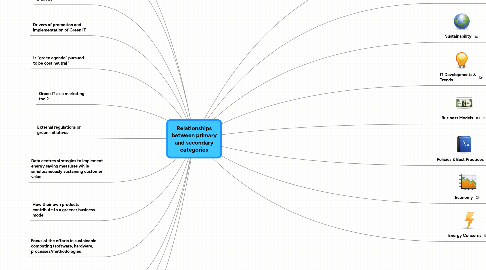
1. The understanding of Green IT/ Sustainable Computing
2. The role in company and its association and exposure to Green IT
3. Awareness of Green IT in the organisation and industry
4. Drivers of promotion and implementation of Green IT
5. Is “green agenda” pursued to be cost neutral?
6. Green IT as a marketing tool?
7. External regulations or green initiatives
8. Data centres strategies to implement energy saving measures while simulteaneously sustaining customer value
9. How their own products contribute to a greener business model
10. Focus of the efforts in sustainable computing (software, hardware, processes/methodologies
11. Some of Green performance or CSR indicators to measure the success of green objectives.
12. Main hindrances of realisation of Green IT within the company
13. Main hindrances of realisation of Green IT in the industry
14. Product Life-Cycle
14.1. Procurement (IPR)
14.2. Production
14.3. Distribution
14.4. Recycling & Disposal
15. IT Components & Energy Consumption
15.1. IT Hardware
15.1.1. Servers
15.1.2. Storage
15.1.3. Cooling Systems (Fans)
15.1.4. Work Stations & Thin Clients
15.1.5. ChipTechnology
15.1.6. Network Infrastructure
15.2. Mobile Computing
15.2.1. Battery Life
15.2.2. Screen Efficiency
15.2.3. Geo-Computation (Satellites)
15.2.4. Life-Cycle Reduction
15.2.5. Mobile Chip Technology
15.3. Systems & Consolidation Methodologies
15.3.1. Cloud Computing
15.3.2. Network Grids
15.3.3. Remote Access
15.3.4. Virtualization
15.3.5. Internet
15.4. IT Software
15.4.1. Operating Systems
15.4.2. Planning & Design Software
15.4.3. Power Management Software
15.4.3.1. Corporate
15.4.3.2. End Users
15.4.4. Global Simulation Models
15.5. Office & Data Centres
15.5.1. A/C Cooling
15.5.2. Efficiency vs. Carbon Solutions
15.5.3. Buildings (LEED)
15.5.4. External Climate Utilization
16. Sustainability
16.1. Definition
16.2. 3 pillars
16.2.1. Social
16.2.2. Economic
16.2.3. Environmental
16.3. Triggers
16.3.1. Degradation of environment
16.3.1.1. Waste Polution
16.3.2. Globalisation
16.3.3. Climate change
16.3.3.1. Climate
16.3.3.1.1. CO2 Footprint
16.3.3.1.2. Preservation and Prevention
16.3.3.1.3. Green House Gas Emissions
17. IT Developments & Trends
17.1. New Technology Development
17.1.1. Monitoring Systems
17.2. Accessibility (Out of Scope)
17.2.1. Infrastructure Requirements
17.2.2. Developing Countries
17.3. Awareness
17.3.1. Web 2.0 / Internet
17.3.2. Perception (Consumer vs. Executive)
17.3.3. Behavioural Changes
17.3.4. Labeling & Certifications
18. Business Models
18.1. Business Processes
18.2. Departmental Accountability
18.2.1. Key Performance Indicators
18.2.2. Energy Performance
18.3. Regulation Adherence
18.4. Business Reputation
18.4.1. Brand
18.4.2. Marketing
18.5. Commitment
18.5.1. Top-Down
18.5.2. Budgets
18.5.3. Company Values
18.6. Mergers & Acquisitions
18.7. Collaboration
18.7.1. Client Relationship Management (Partner Relationship)
19. Policies & Best Practices
19.1. Government
19.1.1. GDP
19.1.2. Tax Incentives
19.1.3. Certifications
19.1.4. Energy Pricing (Outside of Scope)
19.1.5. Emissions Trading Scheme (US?)
19.2. Independent Organizations
19.3. Companies & CSR
20. Economy
20.1. Job Creation
20.2. Business Opportunities
20.3. Standard of Living
20.4. Spending
20.5. Market Intricacy (Globalization)
21. Energy Concerns
21.1. Energy Sourcing
21.1.1. Oceanic
21.1.2. Hydro
21.1.3. Solar
21.1.4. Processed Energy (BTU)
21.1.5. Clean vs. Dirty Energy (Peak Time Energy)
21.1.6. Infrastructure
21.1.6.1. Reliability
21.1.6.2. Smart Grid
21.1.6.3. Scalability
21.1.6.4. Convergence
21.2. Energy Storage
21.2.1. Hydro
21.2.2. Batteries
21.2.3. Water Reservoirs
21.2.4. Air Compression
21.2.5. Carbon-Capture
